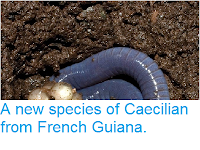Caecilians are limbless burrowing Amphibians found in tropical regions
of Asia, Africa and South America. They resemble Earthworms, with
circular folds on their skin which make them look segmented and skin
covering their eyes (though they can see), though they are true Vertebrates with visible jawbones, which all Worms lack.. Unlike snakes they have
greatly reduced or even absent tails with their anus close to or at the
tips of their bodies. Caecilians are predatory with a well developed
sense of smell. Most Caecilians are found on continents; island dwelling species are very rare in this group.
In a paper published in the journal ZooKeys on 30 October 2019, Andrés Acosta-Galvis, Mauricio Torres, and Paola Pulido-Santacruz of the Instituto de Investigación de Recursos Biológicos Alexander von Humboldt, describe a new species of Caecilian from the western foothills of the Serranía de los Yariguíes in Santander Department, Colombia.
The new species is described from specimens collected during a recent herpetological survey in wet tropical forests of the Serranía de los Yariguíes, between 17 February and 1 May 2018 (i.e. during the dry season). Specimens were found in two separate humid spots near the Río Cascajales, which drains Tropical moist broadleaf forests, within the ecoregion of the Magdalena valley montane forests, in the foothills of the Cordillera Oriental. The collecting technique which was used to obtain specimens of the new species, consisted of first asking local people about the locations where they have spotted Caecilians using the common names of 'Blind Snakes', or 'Captain Worms'('Lombrices capitanas'), or 'Motolas' (this common name is specific for the Department of Santander). Subsequently, the reported sites were visited and inspected to select sites under the shade of vegetation, and where the soil is not compact and very humid (usually associated with water springs that form a mosaic of marshy and dry areas). Collecting efforts were focused in the selected damp microhabitats, digging with a hoe to a depth of approximately 20 cm.
The new species is placed in the genus Caecilia and given the specific name pulchraserrana, meaning 'beautiful mountian' in reference to the La Belleza (The Beautiful) municipality in the western foothills of the Serranía de Los Yariguíes (Los Yariguíes Mountains), where the species was discovered. The species is described from five adult specimens, three females and two males, which range from 195 to 232 mm in length, and are dark brownish in colour with thin salmon-coloured chromatophores; the ventral surface of body slightly paler than dorsum, and the annular grooves on sides of body slightly darker than general body colour. The jaw margins, area between the eye and naris, and tentacular regions are pink-orange (salmon), the eyeballs are completely violet blue, and the periorbital region is salmon.
Caecilia pulchraserrana, adult female specimens. Acosta-Galvis et al. (2019).
See also...
Follow Sciency Thoughts on Facebook.





